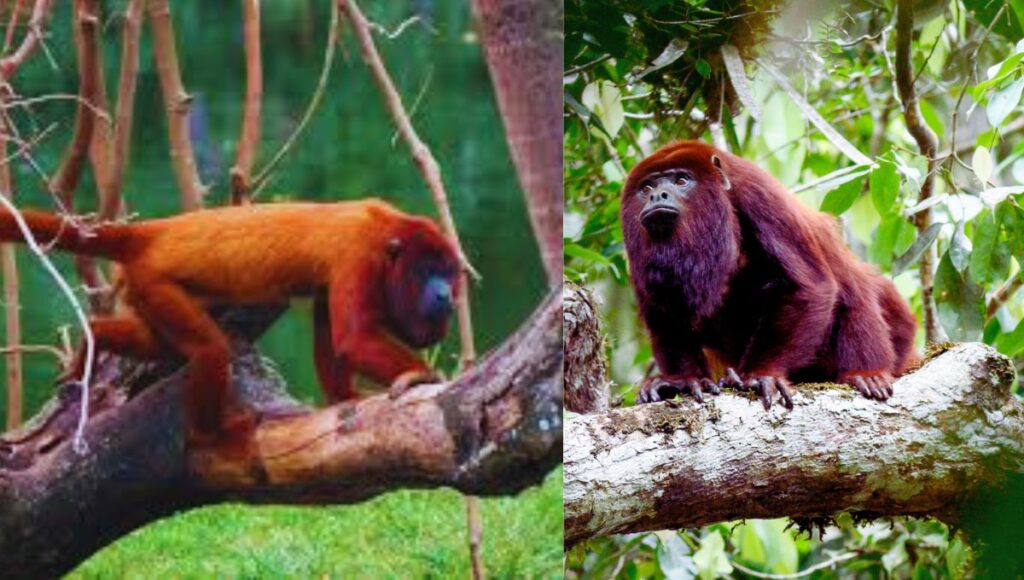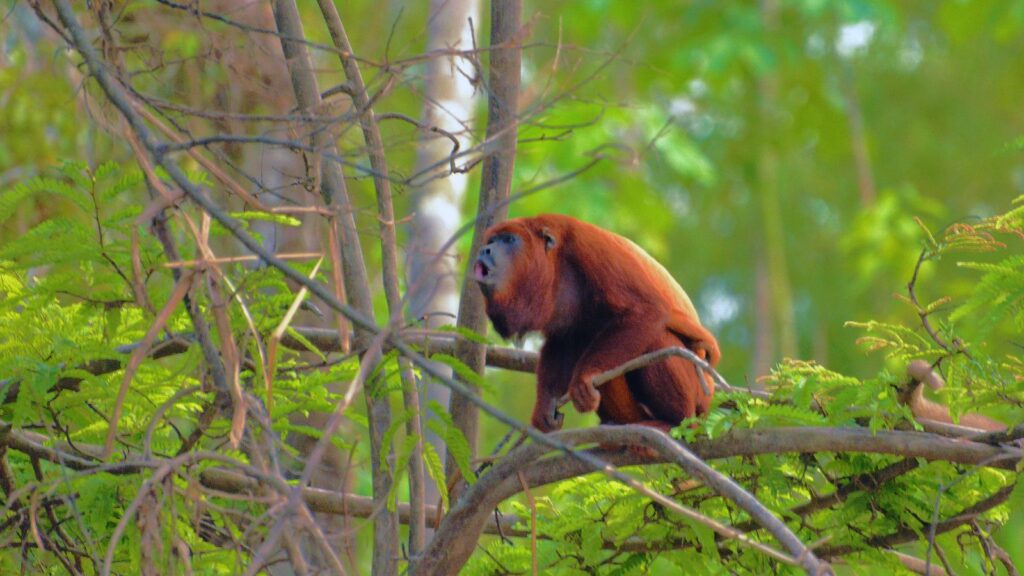Colombian Red Howlers, also known as Venezuelan Red Howlers, are a type of New World monkey, endemic to the North Western part of South America. The species is different from other red howlers found in Bolivia, Trinidad and Guyana. The monkey species is well-known for its sounds (howl) and belongs to the family of Atelidae and infraorder Platyrrhini.

Table of Contents
Everything About Colombian Red Howlers:
Scientific Classification:
| Domain: | Eukaryota |
| Kingdom: | Animalia |
| Phylum: | Chordata |
| Class: | Mammalia |
| Order: | Primates |
| Suborder: | Haplorhini |
| Infraorder: | Simiiformes |
| Family: | Atelidae |
| Genus: | Alouatta |
| Species: | Alouatta seniculus |
Relatives:
| Common Name | Scientific Name | Distribution | IUCN Status |
| Ursine Red Howler | Alouatta arctoidea | Venezuela | Least Concern |
| Jurua Red Howler | Alouatta juara | Peru and Brazil | Least Concern |
Physical Appearance:
Both the males and females have reddish-brown fur in shades but the colour of shade changes with their age. Stubbed grey noses, mouths and enlarged voice boxes, which drop beneath their chins, look similar to thick red bears, giving a rabbinical appearance.
While howling, they pucker their lips and put extra weight into the sound. The underside of the last third of their prehensile tails are furless and it helps them to grip tree branches firmly. Sexual dimorphism is not much as the males and females are almost similar in size.
Size and Weight:

The males are 49-72 cm long whereas the females are approximately 46-57 cm long. The males weigh around 5.4-9 kg whereas the females are about 4.2-7 kg. Both have a long prehensile tail of 49-75 cm.
The jaw bone of the Venezuelan Red howlers is large, especially the mandible bones. The howler monkeys also have inflated bulla, which is the bony encasement of the middle ear. This characteristic is very common among other New World Monkeys.
New World Monkey:
New World Monkeys are the five families of primates that are found in the tropical region of Mexico and South America. The 5 families are ranked together as the Ceboidea and belong to infra order Platyrrhini.
Five families of New World Monkeys:
- Callitrichidae
- Cebidae
- Aotidae
- Pitheciidae
- Atelidae
Lifespan:
On average, the Colombian Red Howlers live up to 25 years in the wild.
Range and Habitat:
The Colombian Red Howlers are found throughout the Western Amazon basin in South America. Especially, in Western Brazil, Colombia, Ecuador, Peru, Venezuela, Trinidad and Tobago.
Habitat:
The red howlers are more common at the elevation of 600-2300 ft, although they can be found at a height of 10,500 ft as well. Their preferred habitat includes primary lowlands, rainforests, swamps etc. The red howlers love to live in any forest with an abundance of food.
Behaviour:
The Colombian Red Howlers are diurnal species which spend 70% of their day resting at upper canopies to digest the food. They spend 5-10% of the day foraging and the rest of the day is used in feeding. They can consume around 3 kgs of food per day.
Once the howlers used to acquire food with less foraging as there was an abundance of food. Due to global warming and adverse weather conditions, the howlers shifted from quantity-based to quality-based diets, which are rich in energy resources and protein.
Daily Life and Group Behaviour:

The group of Venezuelan Red Howlers consists of 3-9 members of which one or two are males and others are females and offerings. The group is polygynous and due to the very low female-to-male ratio, the competition for mating is very high. There is usually one dominant male in the group, known as “Alpha Male”. The alpha male is responsible for finding new food sites and defending the members of the group. The females of the group are responsible for raising their offspring. Allogrooming or troops mate grooming one another is common among the species.
Sound:

Colombian Red Howlers are famous for their “dawn chorus”. The sound is known as howling and thus the species is known as red howlers. The howling is often performed by males and can be heard up to 5 km away in the forest. The roar ensures their presence in the area and prevents confrontation among the group. Because of their low-sugar diets, they cannot perform lots of physical activities. Thus, conserving energy by avoiding fighting is a part of their lifestyle. The howling helps to spread the group and lower the competition over food in the region.
Diets:
The Venezuelan Red Howlers are folivores or they feed on leaves. Their diet also consists of nuts, small insects, flowers, fruits and buds for important nutrients and sugar content for growth.
Reproduction:
The competition for sexual mating in the species is very high and fierce. This competition is often proved to be dangerous for both parties. A sexual interaction often starts with consortships by which a male and a female begin to spend lots of time together. Eventually, the female initiates copulation by approaching the male and moving her tongue rhythmically. If the male doesn’t show interest, then the female moves to another male.

The average gestation period is 190 days and the breeding interval is 17 months. The menstrual period lasts for 2-4 days and occurs every 17 days. The infants stay with their mothers for 18-24 months. A female reaches sexual maturity at 4-5 years whereas a male reaches sexual maturity at 6-7 years of age.
Reaching sexual maturity, males are expelled from natal groups and forced to join a foreign group. There the male competes with existing leaders and if the newcomer wins, he engages in infanticide or kills the infants of the previous leader. By doing this they not only kill the competition but also force the female members to mate with him. According to reports, only 25%-30% of offspring survive the male invasions.
Ecological Importance:
The Colombian Red Howlers help in spreading seeds while eating and also by their stools. It also helps to spread the vegetation.
Threats:
The Red Howlers face many anthropogenic threats in the wild.
- Hunting for bushmeat, agricultural deforestation, ranching etc. lead to the extinction of the species in Peru.
- In Colombia, deforestation and habitat loss is a major concern.
- Damming and Hydroelectric agriculture practices proved to be harmful to the red howlers in Brazil.
- They are also killed for their enlarged hyoid (a U-shaped bone on the neck that supports the tongue) or skin.
Predators:
Jaguars, Pumas, Harpy Eagles and other larger birds are the main predators of Colombian Red Howlers.
Conservation Status:
The Colombian Red Howlers are listed in the IUCN Red List Of Threatened Species as Least Concern.
10 Fun Facts About Colombian Red Howlers:
- The Colombian Red Howlers are also known as Venezuelan Red Howlers.
- The species is known for its ‘dawn chorus’ by male red howlers which can be heard 5 km away.
- Males and Females are very similar in size and physical appearance. The sexual dimorphism is not much in the species.
- Their enlarged voice box is covered with fur which drops beneath the chin and looks like thick red beards.
- The monkey has an inflated bulla which is a bony encasement of the middle ear. It is very rare among New World monkeys.
- The monkeys spend 70% of their time resting just to digest their food.
- Colombian Red Howler can consume 3 kg of food per day.
- The monkeys avoid fighting to preserve energy as they have low-sugar diets which leads to lesser physical activities.
- Due to the very absurd males and females ratio, the sexual competition among the species is very high and fierce.
- In Peru, Colombian Red Howlers hunt for their meats.
Also Read:
Stone Sheep: 6 Best Places to Watch Them
Smoky Jungle Frog: Everything About the Frog in Only 2 Minutes